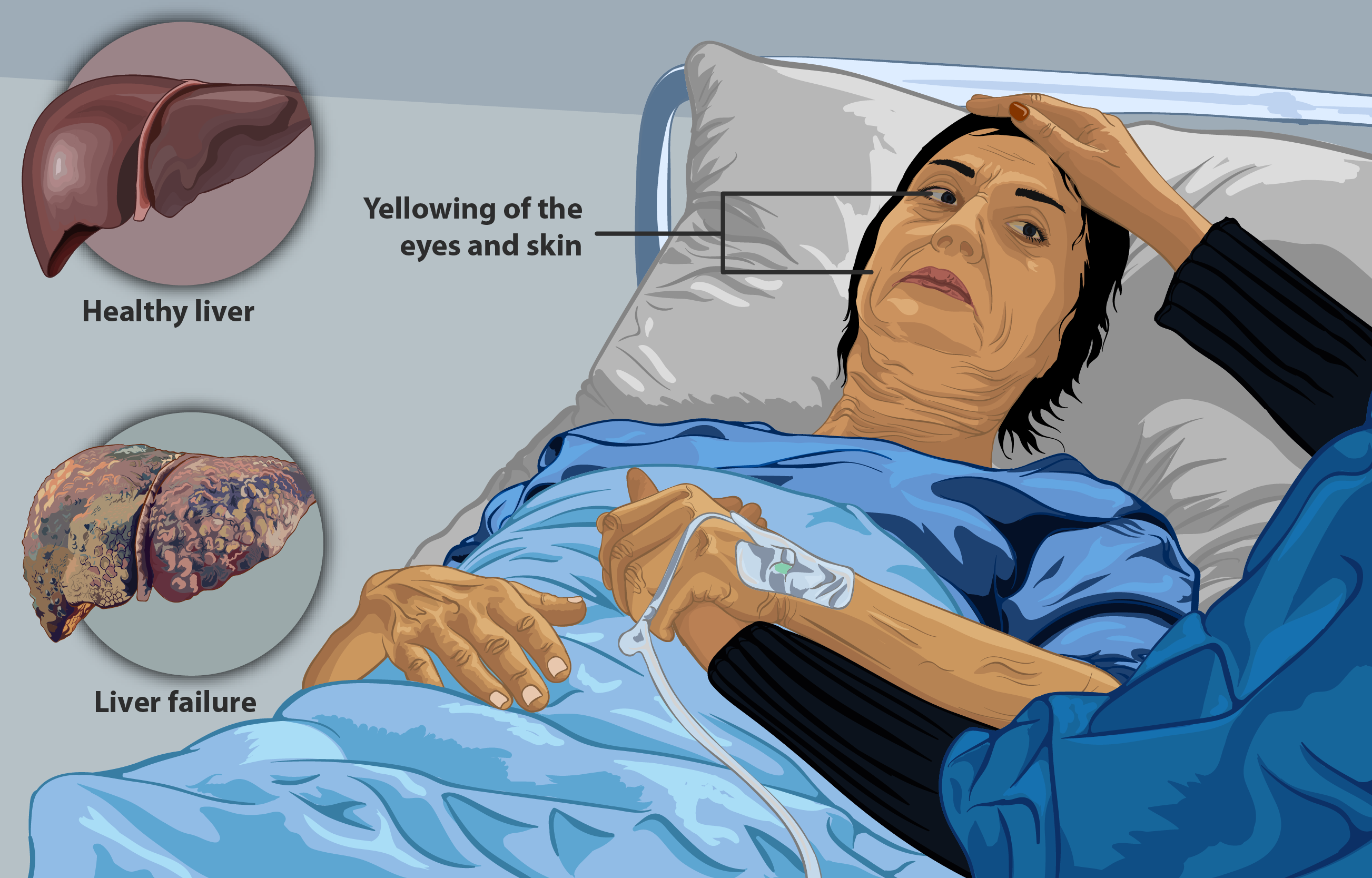|
Acute Hepatitis
Hepatitis is inflammation of the liver tissue. Some people or animals with hepatitis have no symptoms, whereas others develop yellow discoloration of the skin and whites of the eyes (jaundice), poor appetite, vomiting, tiredness, abdominal pain, and diarrhea. Hepatitis is '' acute'' if it resolves within six months, and '' chronic'' if it lasts longer than six months. Acute hepatitis can resolve on its own, progress to chronic hepatitis, or (rarely) result in acute liver failure. Chronic hepatitis may progress to scarring of the liver (cirrhosis), liver failure, and liver cancer. Hepatitis is most commonly caused by the virus ''hepatovirus A'', '' B'', '' C'', '' D'', and '' E''. Other viruses can also cause liver inflammation, including cytomegalovirus, Epstein–Barr virus, and yellow fever virus. Other common causes of hepatitis include heavy alcohol use, certain medications, toxins, other infections, autoimmune diseases, and non-alcoholic steatohepatitis (NASH). Hepatit ... [...More Info...] [...Related Items...] OR: [Wikipedia] [Google] [Baidu] |
Alcoholic Hepatitis
Alcoholic hepatitis is hepatitis (inflammation of the liver) due to excessive intake of alcohol. Patients typically have a history of at least 10 years of heavy alcohol intake, typically 8–10 drinks per day. It is usually found in association with fatty liver, an early stage of alcoholic liver disease, and may contribute to the progression of fibrosis, leading to cirrhosis. Symptoms may present acutely after a large amount of alcoholic intake in a short time period, or after years of excess alcohol intake. Signs and symptoms of alcoholic hepatitis include jaundice (yellowing of the skin and eyes), ascites (fluid accumulation in the abdominal cavity), fatigue and hepatic encephalopathy (brain dysfunction due to liver failure). Mild cases are self-limiting, but severe cases have a high risk of death. Severity in alcoholic hepatitis is determined several clinical prediction models such as the Maddrey's Discriminant Function and the MELD score. Severe cases may be treated with glu ... [...More Info...] [...Related Items...] OR: [Wikipedia] [Google] [Baidu] |
Diarrhea
Diarrhea (American English), also spelled diarrhoea or diarrhœa (British English), is the condition of having at least three loose, liquid, or watery bowel movements in a day. It often lasts for a few days and can result in dehydration due to fluid loss. Signs of dehydration often begin with loss of the normal stretchiness of the skin and irritable behaviour. This can progress to decreased urination, loss of skin color, a fast heart rate, and a decrease in responsiveness as it becomes more severe. Loose but non-watery stools in babies who are exclusively breastfed, however, are normal. What is diarrhea? How is it caused, treated and prevented? (see also script)The most common cause is an infection of the intestines due to a virus, bacterium, or parasite—a condition also known as gastroenteritis. These infections are often acquired from food or water that has been contaminated by feces, or directly from another person who is infected. The three types of diarrhea ... [...More Info...] [...Related Items...] OR: [Wikipedia] [Google] [Baidu] |
Epstein–Barr Virus
The Epstein–Barr virus (EBV), also known as human herpesvirus 4 (HHV-4), is one of the nine known Herpesviridae#Human herpesvirus types, human herpesvirus types in the Herpesviridae, herpes family, and is one of the most common viruses in humans. EBV is a DNA virus#Double-stranded DNA viruses, double-stranded DNA virus. EBV is the first identified oncogenic virus, a virus that can cause cancer. EBV establishes permanent infection in human B cells. It uncommonly causes infectious mononucleosis and is also tightly linked to many Malignancy, malignant diseases (cancers and autoimmune diseases). Various vaccine formulations have been tested in animals and humans; however, none of them were able to prevent EBV infection, thus, no vaccine has been approved to date. Infectious mononucleosis ("mono" or "glandular fever"), is characterized by extreme fatigue, fever, sore throat, and swollen lymph nodes. EBV is also associated with various non-malignant, premalignant, and malignant E ... [...More Info...] [...Related Items...] OR: [Wikipedia] [Google] [Baidu] |
Cytomegalovirus
''Cytomegalovirus'' (CMV) (from ''cyto-'' 'cell' via Greek - 'container' + 'big, megalo-' + -''virus'' via Latin 'poison') is a genus of viruses in the order '' Herpesvirales'', in the family '' Herpesviridae'', in the subfamily '' Betaherpesvirinae''. Humans and other primates serve as natural hosts. The 11 species in this genus include '' human betaherpesvirus 5'' (HCMV, human cytomegalovirus, HHV-5), which is the species that infects humans. Diseases associated with HHV-5 include mononucleosis and pneumonia, and congenital CMV in infants can lead to deafness and ambulatory problems. In the medical literature, most mentions of CMV without further specification refer implicitly to human CMV. Human CMV is the most studied of all cytomegaloviruses. MX2/MXB protein was identified as a restriction factor for herpesviruses, which acts at a very early stage of the replication cycle and MX2/MXB restriction of herpesvirus requires GTPase activity. Taxonomy Within the '' Her ... [...More Info...] [...Related Items...] OR: [Wikipedia] [Google] [Baidu] |
Hepatitis D Virus
Hepatitis D is a type of viral hepatitis caused by the hepatitis delta virus (HDV). HDV is one of five known hepatitis viruses: A, B, C, D, and E. HDV is considered to be a satellite (a type of subviral agent) because it can propagate only in the presence of the hepatitis B virus (HBV). Transmission of HDV can occur either via simultaneous infection with HBV (coinfection) or superimposed on chronic hepatitis B or hepatitis B carrier state ( superinfection). HDV infecting a person with chronic hepatitis B (superinfection) is considered the most serious type of viral hepatitis due to its severity of complications. These complications include a greater likelihood of experiencing liver failure in acute infections and a rapid progression to liver cirrhosis, with an increased risk of developing liver cancer in chronic infections. In combination with hepatitis B virus, hepatitis D has the highest fatality rate of all the hepatitis infections, at 20%. A recent estimate from 2020 sugge ... [...More Info...] [...Related Items...] OR: [Wikipedia] [Google] [Baidu] |
Hepatitis C Virus
The hepatitis C virus (HCV) is a small (55–65 nm in size), enveloped, positive-sense single-stranded RNA virus of the family ''Flaviviridae''. The hepatitis C virus is the cause of hepatitis C and some cancers such as liver cancer ( hepatocellular carcinoma, abbreviated HCC) and lymphomas in humans. Taxonomy The hepatitis C virus belongs to the genus '' Hepacivirus'', a member of the family ''Flaviviridae''. Before 2011, it was considered to be the only member of this genus. However a member of this genus has been discovered in dogs: canine hepacivirus. There is also at least one virus in this genus that infects horses. Several additional viruses in the genus have been described in bats and rodents. Structure The hepatitis C virus particle consists of a lipid membrane envelope that is 55 to 65 nm in diameter. Two viral envelope glycoproteins, E1 and E2, are embedded in the lipid envelope. They take part in viral attachment and entry into the cell. Within the e ... [...More Info...] [...Related Items...] OR: [Wikipedia] [Google] [Baidu] |
Hepatitis B Virus
Hepatitis B virus (HBV) is a partially double-stranded DNA virus, a species of the genus '' Orthohepadnavirus'' and a member of the '' Hepadnaviridae'' family of viruses. This virus causes the disease hepatitis B. Classification Hepatitis B virus is classified in the genus '' Orthohepadnavirus'', which contains 11 other species. The genus is classified as part of the '' Hepadnaviridae'' family, which contains four other genera, '' Avihepadnavirus'', '' Herpetohepadnavirus'', '' Metahepadnavirus'' and '' Parahepadnavirus''. This family of viruses is the only member of the viral order ''Blubervirales''. Viruses similar to hepatitis B have been found in all apes (orangutans, gibbons, bonobos, gorillas and chimpanzees), in Old World monkeys, and in New World woolly monkeys (the woolly monkey hepatitis B virus), suggesting an ancient origin for this virus in primates. The virus is divided into four major serotypes (adr, adw, ayr, ayw) based on antigenic epitopes present on it ... [...More Info...] [...Related Items...] OR: [Wikipedia] [Google] [Baidu] |
Hepatovirus A
Hepatitis A is an infectious liver disease caused by Hepatitis A virus (HAV); it is a type of viral hepatitis. Many cases have few or no symptoms, especially in the young. The time between infection and symptoms, in those who develop them, is two to six weeks. When symptoms occur, they typically last eight weeks and may include nausea, vomiting, diarrhea, jaundice, fever, and abdominal pain. Around 10–15% of people experience a recurrence of symptoms during the six months after the initial infection. Acute liver failure may rarely occur, with this being more common in the elderly. It is usually spread by eating food or drinking water contaminated with infected feces. Undercooked or raw shellfish are relatively common sources. It may also be spread through close contact with an infectious person. While children often do not have symptoms when infected, they are still able to infect others. After a single infection, a person is Immunity (medical), immune for the rest of their li ... [...More Info...] [...Related Items...] OR: [Wikipedia] [Google] [Baidu] |
Acute Liver Failure
Acute liver failure is the appearance of severe complications rapidly after the first signs (such as jaundice) of liver disease, and indicates that the liver has sustained severe damage (loss of function of 80–90% of liver cells). The complications are hepatic encephalopathy and impaired protein synthesis (as measured by the levels of serum albumin and the prothrombin time in the blood). The 1993 classification defines ''hyperacute'' as within 1 week, ''acute'' as 8–28 days, and ''subacute'' as 4–12 weeks; both the speed with which the disease develops and the underlying cause strongly affect outcomes. Signs and symptoms The main features of acute liver failure are rapid-onset jaundice, weakness, and eventually, changes in mental status that can begin as mild confusion but progress to coma, known as hepatic encephalopathy. Encephalopathy and cerebral edema In ALF, hepatic encephalopathy leads to cerebral edema, coma, brain herniation, and eventually death. Detection of e ... [...More Info...] [...Related Items...] OR: [Wikipedia] [Google] [Baidu] |




